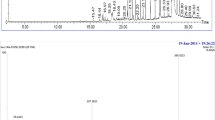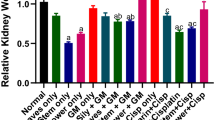Abstract
Cisplatin is widely used in anticancer therapy, but a substantial percentage of patients who receive the therapeutic dose of cisplatin develop nephrotoxicity. Hepatotoxicity may also develop after a single dose or low repeated doses of cisplatin. Ulva fasciata is an edible seaweed, commonly known as sea lettuces have also been shown various biological activities. In this study, ethanol extract and its solvent fractions (n-hexane and chloroform) of U. fasciata were given (orally) to different groups of rats for 10 days. Injury to the kidney was induced by administrating cisplatin, intraperitoneally (i.p.) to rats at a dose of 7 mg/kg body weight (b.w.) dissolved in 1 mL saline, at 5th day of the experiment. At 10th day rats were sacrificed and kidney parameters (creatinine, urea, and blood urea nitrogen (BUN)) and electrolyte balance (Ca++, Mg++, K+, and Na+) in serum were determined, while oxidative stress markers glutathione (GSH), catalase (CAT) and malondialdehyde (MDA), and inflammatory cytokines, tumor necrosis factor (TNF α), and interleukin (IL-6) were determined in kidney tissues. Histological examination of the kidney was also performed to examine the changes in kidney tissues. Cisplatin caused adverse effects on blood parameters, antioxidants, and inflammatory markers with severe renal tubular injury in kidney tissues. Ethanol extract of U. fasciata and its fractions effectively improved these disorders and diminished the renal dysfunction. However, ethanol extract was found more effective in attenuating the adverse effect of cisplatin than its fractions. n-Hexane-soluble fraction that was subjected to GC-FID and GC-MS analysis revealed the presence of several compounds and some of them are new from this source. It could be concluded that the U. fasciata possesses nephroprotective effect and can attenuate cisplatin-induced renal dysfunction. Since U. fasciata is an edible seaweed, it may be used as a diet supplement.


Similar content being viewed by others
Data availability
The data will be provided on request.
References
Abdel-Aziz MFA, Ragab MA (2017) Effect of use of fresh macro algae (Seaweed) Ulva fasciata and Enteromorphaflaxusa with or without artificial feed on growth performance and feed utilization of Rabbitfish (Siganusrivulatus) fry. J Aquac Res Dev 8(482):2. https://doi.org/10.4172/2155-9546.1000482
Abdel-Daim MM, Abuzead SM, Halawa SM (2013) Protective role of Spirulina platensis against acute deltamethrin-induced toxicity in rats. PLoS One 8(9):e72991
Abdel-Daim MM, Abushouk AI, Donia T, Alarifi S, Alkahtani S, Aleya L, Bungau SG (2019) The nephroprotective effects of allicin and ascorbic acid against cisplatin-induced toxicity in rats. Environ Sci Pollut Res Int 26(13):13502–13509. https://doi.org/10.1007/s11356-019-04780-4
Abirami RG, Kowsalya S (2013) Antidiabetic activity of Ulva fasciata and its impact on carbohydrate metabolism enzymes in alloxan induced diabetic rats. Int J Res Phytochem Pharmacol 3(3):136–141
Akca G, Eren H, Tumkaya L, Mercantepe T, Horsanali MO, Deveci E, Yilmaz A (2018) The protective effect of astaxanthin against cisplatin-induced nephrotoxicity in rats. Biomed Pharmacother 100:575–582
Ali S, Khan MA, Hussain MM, Qamar A, Bashir S (2019) Evaluation of cisplatin induced genotoxicity in male Sprague dawley rats. Pak J Physiol 15(1):21–24
Alrashed AA, El-Kordy EA (2019) Possible protective role of panax ginseng on cisplatin-induced hepatotoxicity in adult male albino rats (Biochemical and Histological Study). J Microsc Ultrastruct 7(2):84–90
Ambreen, Hira K, Tariq A, Ruqqia, Sultana V, Ara J (2012) Evaluation of biochemical component and antimicrobial activity of some seaweeds occurring at Karachi coast. Pak J Bot 44:1799–1803
Amirshahrokhi K, Khalili AR (2015) Thalidomide ameliorates cisplatin-induced nephrotoxicity by inhibiting renal inflammation in an experimental model. Euro J Inflamm 38(2):476–484
Ben Saad H, Gargouri M, Kallel F, Chaabene R, Boudawara T, Jamoussi K, Magné C, MounirZeghal K, Hakim A, Ben Amara I (2017) Flavonoid compounds from the red marine alga Alsidiumcorallinum protect against potassium bromate-induced nephrotoxicity in adult mice. Environ Toxicol 32:1475–1486
Cagin YF, Atayan Y, Sahin N, Parlakpinar H, Polat A, Vardi N, Yildiz A (2016) Beneficial effects of dexpanthenol on mesenteric ischemia and reperfusion injury in experimental rat model. Free Radic Res 50(3):354–365
Chakraborty K, Paulraj R (2010) Sesquiterpenoids with free-radical-scavenging properties from marine macroalga Ulva fasciata Delile. Food Chem 122(1):31–41
Ciarimboli G (2011) Role of organic cation transporters in drug-induced toxicity. Expert Opin Drug Metab Toxicol 7(2):159–174
Cüre MC, Cüre E, Kalkan Y, Kırbaş A, Tümkaya L, Yılmaz A, Yüce S (2016) Infliximab modulates cisplatin-induced hepatotoxicity in rats. Balk Med J 33(5):504
EkinciAkdemir F, Albayrak M, Çalik M, BayirGülçin I (2017) The protective effects of p-coumaric acid on acute liver and kidney damages induced by cisplatin. Biomed Pharmacother 5(2):18. https://doi.org/10.3390/biomedicines5020018
Farhat H, Urooj F, Tariq A, Sultana S, Ansari M, Ahmad VU, Ehteshamul-Haque S (2019) Evaluation of antimicrobial potential of endophytic fungi associated with healthy plants and characterization of compounds produced by endophytic Cephalosporiumand Fusarium solani. Biocatal Agric Biotechnol 18:101043. https://doi.org/10.1016/j.bcab.2019
Ferreira VL, Borba HHL, Bonetti ADF, Leonart L, Pontarolo R (2018) Cytokines and interferons: types and functions. In: Auto-antibodies and cytokines. IntechOpen. https://doi.org/10.5772/intechopen.74550.
Govindan SM, Thomas J, Pratheesh PT, Kurup GM (2012) Ex vivo anticoagulant activity of the polysaccharide isolated from Ulva fasciata. Int J Life Sci Biotechnol Pharma Res 1:194–197
Ibrahim A, Al-Hizab FA, Abushouk AI, Abdel-Daim MM (2018) Nephroprotective effects of benzyl isothiocyanate and resveratrol against cisplatin-induced oxidative stress and inflammation. Front Pharmacol 9:1268. https://doi.org/10.3389/fphar.2018.0126
Khalid S, Abbas M, Saeed F, Bader-Ul-Ain H, Suleria HAR (2018) Therapeutic Potential of Seaweed Bioactive Compounds. In: Seaweed Biomaterials. Intech Open. https://doi.org/10.5772/intechopen.74060
Kim DH, Park MH, Choi YJ, Chung KW, Park CH, Jang EJ, An HJ, Yu BP, Chung HY (2013) Molecular study of dietary heptadecane for the anti-inflammatory modulation of NF-kB in the aged kidney. PLoS One 8(3):e59316
Kim IH, Kwon MJ, Jung JH, Nam TJ (2018) Protein extracted from Porphyra yezoensis prevents cisplatin-induced nephrotoxicity by down regulating the MAPK and NF-κB pathways. Int J Mol Med 41(1):511–520
Koyuncu I, Kocyigit A, Gonel A, Arslan E, Durgun M (2017) The protective effect of Naringeninoxime on cisplatin-induced toxicity in rats. Biochem Res Int 2017:1–9. https://doi.org/10.1155/2017/9478958
Kucuk A, Kabadere S, Tosun M, Koken T, Kinaci MK, Isikli B, Erkasap N (2009) Protective effects of doxycycline in ischemia/reperfusion injury on kidney. J Physiol Biochem 65(2):183–191
Kuriakose GC, Kurup MG (2010) Effects of Aulosira fertilisima against cisplatin-induced nephrotoxicity and oxidative stress in rats. Ren Fail 32(2):224–233
Lee S, Kim W, Moon SO, Sung MJ, Kim DH, Kang KP, Park SK (2006) Rosiglitazone ameliorates cisplatin-induced renal injury in mice. Nephrol Dial Transplant 21(8):2096–2105
Livak KJ, Schmittgen TD (2001) Analysis of relative gene expression data using real-time quantitative PCR and the 2−ΔΔCT method. Methods 25(4):402–408
Ma X, Yan L, Zhu Q, Shao F (2017) Puerarin attenuates cisplatin-induced rat nephrotoxicity: The involvement of TLR4/NF-κB signaling pathway. PLoS One 12(2):e0171612
Matloub AA, El-Sherbini M, Borai IH, Ezz MK, Rizk MZ, Aly HF, Fouad GI (2013) Assessment of anti-hyperlipidemic effect and physco-chemical characterization of water soluble polysaccharides from Ulva Fasciata Delile. Res J Appl Sci 9(4):2983–2993
Mi XJ, Hou JG, Wang Z, Han Y, Ren S, Hu JN, Li W (2018) The protective effects of maltol on cisplatin-induced nephrotoxicity through the AMPK-mediated PI3K/Akt and p53 signaling pathways. Sci Rep 8(1):1–12
Moron MS, Depierre JW, Mannervik B (1979) Levels of glutathione, glutathione reductase and glutathione S-transferase activities in rat lung and liver. Biochim Biophys Acta Gen Subj 582(1):67–78
Namvar F, Mohamad R, Baharara J, Zafar-Balanejad S, Fargahi F, Rahman HS (2013) Antioxidant, anti-proliferative and anti-angiogenesis effects of polyphenol-rich seaweed (Sargassummuticum). Biomed Res Int 2013:1–9. https://doi.org/10.1155/2013/604787
NRC (National Research Council) (1995) Nutrient requirements of laboratory animals, Fourth Revised Edition, The National Academies Press, Washington, D.C. https://doi.org/10.17226/4758
Ohkawa H, Ohishi N, Yagi K (1979) Assay for lipid peroxides in animal tissues by thiobarbituric acid reaction. Anal Biochem 95(2):351–358
Osman AM, El-Sayed EM, El-Demerdash E, Al-Hyder A, El-Didi M, Attia AS, Hamada FMA (2000) Prevention of cisplatin-induced nephrotoxicity by methimazole. Pharmacol Res 41(1):113–119
Pereira L (2018) Seaweeds as source of bioactive substances and skin care therapy cosmeceuticals, algotheraphy and thalassotherapy. Cosmetics 5(4):68. https://doi.org/10.3390/cosmetics5040068
Perše M, Večerić-Haler Ž (2018) Cisplatin-induced rodent model of kidney injury: characteristics and challenges. Biomed Res Int 2018:1–29. https://doi.org/10.1155/2018/1462802
Priyadharshini S, Bragadeeswaran S, Prabhu K, Ran SS (2011) Antimicrobial and hemolytic activity of seaweed extracts Ulva fasciata (Delile 1813) from Mandapam, Southeast coast of India. Asian Pac J Trop Biomed 1(1):S38–S39
Raj GA, Chandrasekaran M, Jegan S, Venkatesalu V (2016) Phytochemical analysis and antifungal activity of Ulva species from the Kanniyakumari Gulf of Mannar, South Coast India. Nat Prod: Indian J Appl Res 12(3):104
Ravindra P, Bhiwgade A, Kulkarni S, Rataboli PV, Dhume CY (2010) Cisplatin induced histological changes in renal tissue of rat. J Cell Anim Biol 4(7):108–111
Rodeiro I, Olguín S, Santes R, Herrera JA, Pérez CL, Mangas R, Camacho-Carranza R (2015) Gas chromatography-mass spectrometry analysis of Ulva fasciata (Green Seaweed) extract and evaluation of its cyto-protective and anti-genotoxic effects. Evid Based Complement Alternat Med 2015:1–11. https://doi.org/10.1155/2015/520598
Sayed-Ahmed MM, Eissa MA, Kenawy SA, Mostafa N, Calvani M, Osman AMM (2004) Progression of cisplatin-induced nephrotoxicity in a carnitine-depleted rat model. Chemotherapy 50(4):162–170
Sen S, Chakraborty R, Kalita P (2018) Dillenia indica fruit prevents cisplatin-induced kidney injury in experimental rats through modulation of oxidative stress, marker enzyme, and biochemical changes. Nutrire 43(1):15. https://doi.org/10.1186/s41110-018-0074-1
Sherif IO (2015) Amelioration of cisplatin-induced nephrotoxicity in rats by triterpenoidsaponin of Terminaliaarjuna. J Clin Exp Nephrol 19:591–597
Sinha AK (1972) Colorimetric assay of catalase. Anal Biochem 47(2):389–394
Sohail N, Hira K, Tariq A, Sultana V, Ehteshamul-Haque S (2019) Marine macro-algae attenuates nephrotoxicity and hepatotoxicity induced by cisplatin and acetaminophen in rats. Environ Sci Pollut Res 26(24):25301–25311
Tan H, He Q, Li R, Lei F, Lei X (2016) Trillin reduces liver chronic inflammation and fibrosis in carbon tetrachloride (ccl4) induced liver injury in mice. Immunol Investig 45:371–382
Usha R, Maria VRS (2015) Gas chromatography and mass spectrometric analysis of Padina pavonia (L.) Lamour. Bio Disc 6(1):1–5
Van Angelen AA, Glaudemans B, van der Kemp AW, Hoenderop JG, Bindels RJ (2012) Cisplatin-induced injury of the renal distal convoluted tubule is associated with hypomagnesaemia in mice. Nephrol Dial Transplant 28(4):879–889
Wichard T, Charrier B, Mineur F, Bothwell JH, Clerck OD, Coates JC (2015) The green seaweed Ulva: a model system to study morphogenesis. Front Plant Sci 6–72. https://doi.org/10.3389/fpls.2015.00072
Wolf MA, Sciuto CA, Andreoli Moro I (2012) Ulva (Chlorophyta, Ulvales) biodiversity in the North Adriatic Sea (Mediterranean, Italy): Cryptic species and new introductions. J Appl Phycol 48(6):1510–1152
Acknowledgements
Support of Prof. Dr. Viqar Uddin Ahmad (now late), H.E.J. Research Institute of Chemistry, University of Karachi, for GC-MS analysis and Dr. Aisha Begum, Department of Botany, University of Karachi for seaweed identification are acknowledged.
Funding
Financial assistance provided by the Higher Education Commission, Pakistan (Grant # nrpu-4505) is sincerely acknowledged.
Author information
Authors and Affiliations
Contributions
NS and KH collected the seaweed, extracted and fractionated the extracts, and wrote the manuscript. Experiments on animal were conducted by NS and FU. Histopathology was carried out by NS and HK. Molecular work on anti-inflammatory cytokine was conducted by NS, JA, and WK. GC-MS profiling of n-hexane extract was done by NS, HF, and MSA. VS and SE helped in the seaweed collection, supervised research work, and improve the quality of final version of the manuscript. All authors read and approved the final manuscript.
Corresponding author
Ethics declarations
Competing interests
The authors declare that they have no conflict of interest.
Ethics approval and consent to participate
All experiments were conducted according to the rules of the Institutional Animal Ethics Committee (IAEC), University of Karachi.
Consent for publication
Not applicable.
Additional information
Responsible Editor: Mohamed M. Abdel-Daim
Publisher’s note
Springer Nature remains neutral with regard to jurisdictional claims in published maps and institutional affiliations.
Supplementary Information
ESM 1
(DOCX 419 kb)
Rights and permissions
About this article
Cite this article
Sohail, N., Hira, K., Kori, J.A. et al. Nephroprotective effect of ethanol extract and fractions of a sea lettuce, Ulva fasciata against cisplatin-induced kidney injury in rats. Environ Sci Pollut Res 28, 9448–9461 (2021). https://doi.org/10.1007/s11356-020-11321-x
Received:
Accepted:
Published:
Issue Date:
DOI: https://doi.org/10.1007/s11356-020-11321-x




